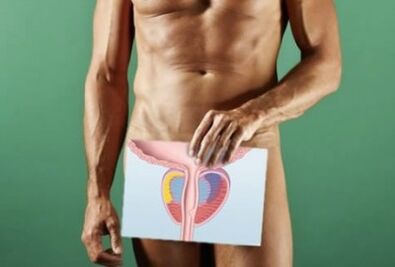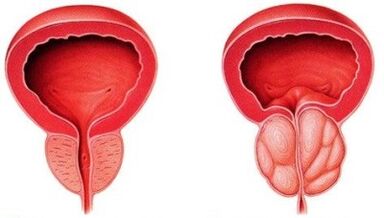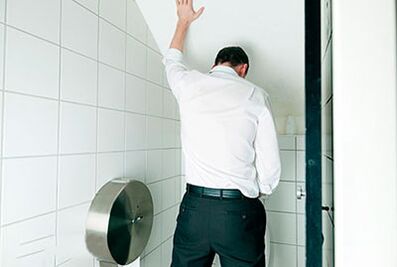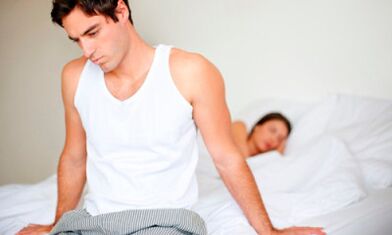Prostatitis is a disease that can suddenly overtake any man.
The urinary system passes through the prostate, which contributes to the manifestation of one of the first signs of the disease - difficulty urinating.
Prostatitis - the beginning
The onset of the disease is always associated with certain conditions of our lives.
There are several types of prostatitis:
- Acute;
- Chronic;
- Infectious (bacterial)
- Non-infectious.

The nomenclature, in this case, is binary, for example, infectious prostatitis can be chronic and acute.
Each type of prostatitis will start differently and will be preceded by its own special occasion. Let's look at them.
Risk factors, occurrence circumstances
- ΣΜΝ. When infected with any sexually transmitted infection from a sexual partner, a man is more likely to get an acute infectious prostate, which can then turn into years. Thus, sexually transmitted diseases will be the first predisposing factor to prostatitis.
- Sedentary lifestyle, sedentary work, apathy for sports and morning exercises, obesity. This is the cause of non-infectious prostatitis, which can be aggravated or with vague symptoms.
- Hypothermia - in this case, the urogenital system suffers from frequent colds, as a result of which inflammation of the bladder, semen, prostate and testicles can occur.
- Age. When a man reaches the age of 40-45, irreversible changes begin in his prostate gland. This is due to male menopause - a direct consequence of hormonal rearrangement in the body. The prostate develops (hyperplasia), which accompanies (or may be accompanied by) the full range of prostatitis symptoms.
Let's generalize once again - these factors increase the chances of prostatitis tenfold.

Next, let's look at the first signs of different types of prostatitis.
Be careful, before engaging in self-diagnosis when the first signs are detected, or in a panicked search for doctor contacts - pay attention to the above risk factors. Maybe you do not have prostatitis!
Symptoms
Acute process
Let us clarify that the first signs of acute prostatitis in most cases are similar in all patients:
- Pain when urinating, after burning
- Temperature rise?
- After the heroic emptying of the bladder, the patient feels that there is still urine in him.
- Complaints of pain in the groin and perineum.
The pains start abruptly, problems with the toilet. This is due to the rapid increase in swelling of the inflamed prostate.

The symptoms may go away on their own, but they do not cause hallucinations: this does not mean that the disease is gone.
Prostatitis becomes chronic. It can take a long time (years) from the first signs of acute prostatitis to the onset of chronic prostatitis.
Years process
The patient may not have had an intense acute period and the disease, bypassing it, has become chronic.
In this case, the symptoms will be as follows:
- Dull pain in the anus after a bowel movement, radiating to the tail
- Normal or irregular pain in the groin
- Going to the toilet is not very difficult, but you need to stretch your stomach a little to start urinating. The patient does not pay much attention to this.
- Sometimes after urination there is a burning sensation in the urethra.
The first signs of chronic prostatitis can appear for a long time. They can disappear and then feel again.
Infectious prostatitis
Often with infectious prostatitis, the patient also carries other sexually transmitted diseases.
Among the first points should be noted:
- Cut in the urethra, blood in the urine
- Temperature rise?
- White urine (pus)
- Frequent urge to use the toilet.
The first signs of bacterial prostatitis are similar to acute prostatitis, as the latter type often occurs precisely because of the efforts of an infectious agent.

Non-infectious prostatitis
After 40 years, a man can find the first signs of non-infectious prostatitis. This is not the bacteria's fault, it's just that time has come.
The prostate grows, which in some way may manifest or may become unnoticed.
If a person has problems, then he ends up in events like:
- Difficulty urinating
- Residual amount of urine in the bladder.

If it causes inflammation of the prostate, then pain, burning and possibly fever are added.
Every prostatitis has basic (main) manifestations in urination problems. The pain may have different localization and intensity, burning at the end of urination and after it may be absent.
Sexual problems occur in 99% of 100% of cases, but this process is long, lasting several years or more.
Among the first signs, there is a weakening of urine pressure. If you need to stretch your abs to start urinating (even if you are not careful), it is time to see a urologist.
This is the first sign of impending prostatitis.
What if you ignore all these symptoms?
Let's say that acute prostatitis has passed by itself (suppose it has passed).
After several days of torture, we easily go to the toilet and the burning sensation and pain have left us.
Euphoria will not last long - chronic inflammation is tied to the prostate, so prostatitis will resemble itself.
This is not the worst, since you can live with such sensations. What is important is what happens inside the prostate.
Let us remember what its function is - to maintain the vital activity of sperm.
Prostatitis inhibits and inhibits this function. As a result of advanced prostatitis, a man may lose the ability to conceive.

Another unpleasant consequence of advanced prostatitis is depression and low mood. The constant problems in the toilet add stress to a man.
Incomplete emptying of the bladder leads to inflammatory processes in it and other parts of the urinary system.
Therefore, do not be inactive.
How is prostatitis diagnosed?
At the first signs of illness, contact your urologist and tell us about your feelings.
Prostatitis is diagnosed by history, anal prostate examination and TRUS.
The other methods are used as a supplement, to identify concomitant diseases or to exclude them.
You can diagnose at home. But prostatitis can be confused with inflammation of the urethra or bladder, so read the diagnosis of prostatitis carefully.
Treatment
The treatment for prostatitis depends on its form.
The main tasks of the doctor are:
- Restoration of a normal ureter. This means that you need to reduce swelling, relieve muscle spasm and stimulate urine production and excretion.
- Fighting an infectious agent or eliminating the cause of prostatitis.
- Relapse prevention (diet, lifestyle and good habits).
- Stimulation of prostate activity - rectal prostate massage.
You can also treat at home, having previously agreed on treatment methods with a urologist. For example, it is useful to place special microclips with herbal teas.
To speed up recovery, your doctor will prescribe physiotherapy.





























